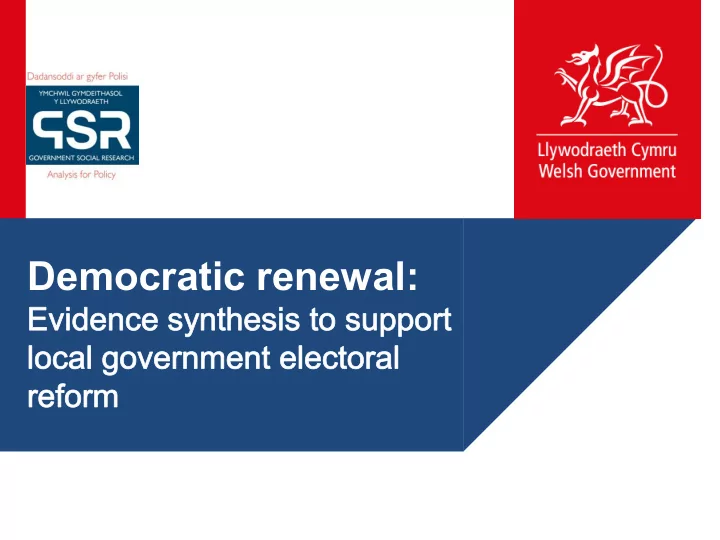

Democratic renewal:
Background & Aims
Methodology Three separate literature searches were completed as part of this report: Search 1: defining the scope of democratic renewal; no temporal or geographic limit given the defining nature; strict search terms & assessment of robustness Search 2: finding methods of civic and democratic engagement; restricted to democratic countries and after 2004; strict search terms & assessments of robustness Search 3: understanding methods of voter engagement and the proposed franchise extension in Wales; snowballing for key words and literature; weaker criteria for robustness but this is noted as a caveat in relevant sections and was necessary given the scarcity of relevant research
Democratic Renewal “ A broad concept that includes methods of enhancing representation through voting, the delegation of power from governments to communities, and the identification of a need to improve current democratic practices. ”
Aims To inform the development of local government electoral reform. To synthesise and appraise evidence related to: civic and democratic engagement; voter engagement (particularly in local elections); and extending voting franchises to 16-17 year olds and foreign nationals.
Civic & Democratic Engagement
Democratic renewal includes… Civic Engagement The participation of citizens in their community. The delegation of power to communities. & Democratic Engagement Relating to political, social and community-based practices. Enhancing representativeness.
Success of engagement is influenced by… Local context: with engagement easier to build on in areas already characterised by historically strong engagement (e.g. industrialised areas with a history of trade unions and collective action). Leadership: innate characteristics (e.g. charismatic leaders), continuity of leadership and civil leadership training have all been found to increase citizen engagement. Public administrators’ attitudes: having trust in citizens so that local knowledge can be galvanised. Ownership: where citizens own some or all of the plans or project. Scale of change: limiting citizen involvement to smaller scale projects or small localities, where there are more defined relationships between communities and public services.
Methods for stimulating engagement include… Nudge theory: including the use of pledges (e.g. making a public commitment to undertake a civic activity or to vote), or reframing decisions to utilise social norms (e.g. providing information about the number of signatories to increase likelihood of other people signing). Inclusive design: where citizens are listened to and provided with evidence that their voices are heard. Utilising technology: for example using online petitions, deliberative polls, or social media as a method of interactive communication.
Voter Engagement
Democratic renewal includes enhancing representation though VOTE voting. One way to do this is by engaging the electorate
Demographic and socioeconomic factors influence voter . X engagement: Age: voter registration and turnout is lower amongst young people, despite younger age groups exhibiting high engagement with other forms of civic behaviour such as volunteering. Education: people educated to degree level are more likely to vote than those without a degree. Ethnicity: BME citizens are less likely to be registered to vote than the population in general. Turnout rates for most BME groups are also lower compared to the population average and this effect is more pronounced amongst young BME citizens.
Three themes can be seen in literature on voter turnout: . X Sense of importance and understanding of local elections: evidence suggests that people with a strong sense of civic duty are more likely to vote. Intrinsic influences: a lack of diversity amongst elected representatives may be negatively affecting perceptions of influence amongst voters. Extrinsic influences: voting behaviour can be affected by the behaviour of others such as household members, or reminders of civic duty.
Extending the Franchise
Consultations look to extending the franchise to three groups… Young Foreign People People in Nationals (aged16-17) Prison There is some The majority of This group was evidence for this evidence is on this deemed out of scope group. group.
Four themes can be seen in literature on 16-17 year olds voting: ‘It makes sense’: Opinion that they contribute to society and therefore ought to have a say in how the country is run. ‘They aren’t ready’: Opinion that they lack experience, education or maturity to make informed voting decisions - evidence does not necessarily support this view. ‘They aren’t interested’: 18-24 have low turnout so expect same for 16-17 - evidence is mixed & does not necessarily support this. ‘This will improve long-term voter turnout’: Limited evidence, but early experiences of voting are thought to be habit forming and therefore lead to life-long voter turnout.
There is conflicting evidence in literature on foreign nationals voting: Foreign nationals show lower turnout in elections but this is at least in part because they are younger with lower educational attainment than the general population. There are specific factors which reduce their likelihood of voting such as perceived stake in the community.
Concluding Remarks
Three key factors can be seen throughout the literature: Perceptions Engagement Education of influence is uneven could help predict engagement
There are some areas which could use more research: Replication in Representative Civic to context samples democratic Using 16-17 year Collecting views Understanding olds not 18-24; of the wider how high interest research in population as or civic Wales; research opposed to engagement can using local as consultations be harnessed opposed to which are self- into democratic national selecting. engagement or government. action.
Recommend
More recommend